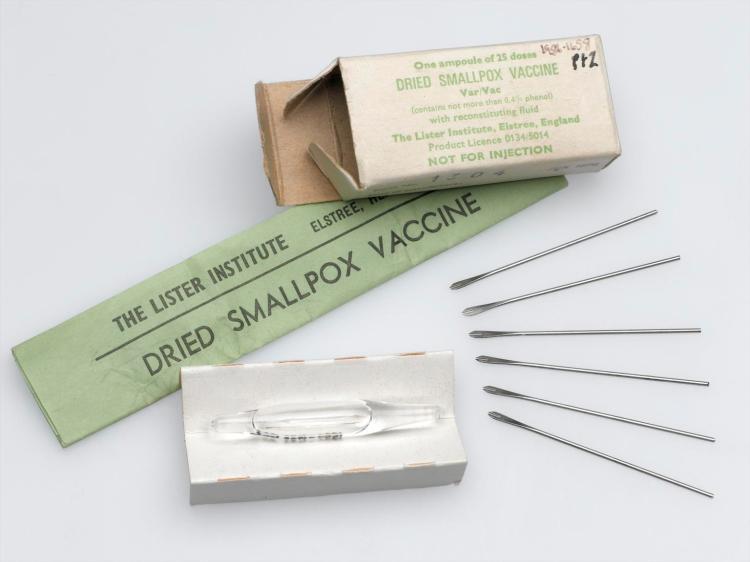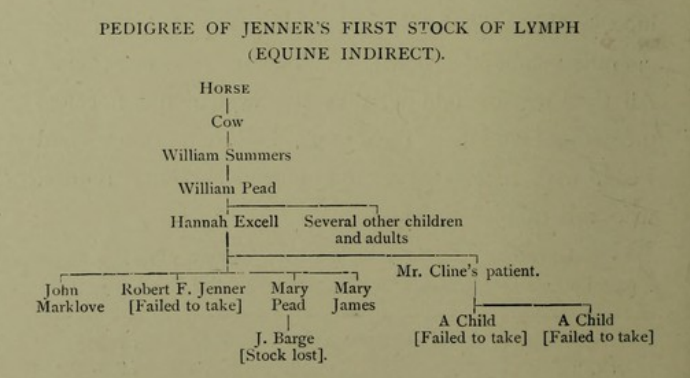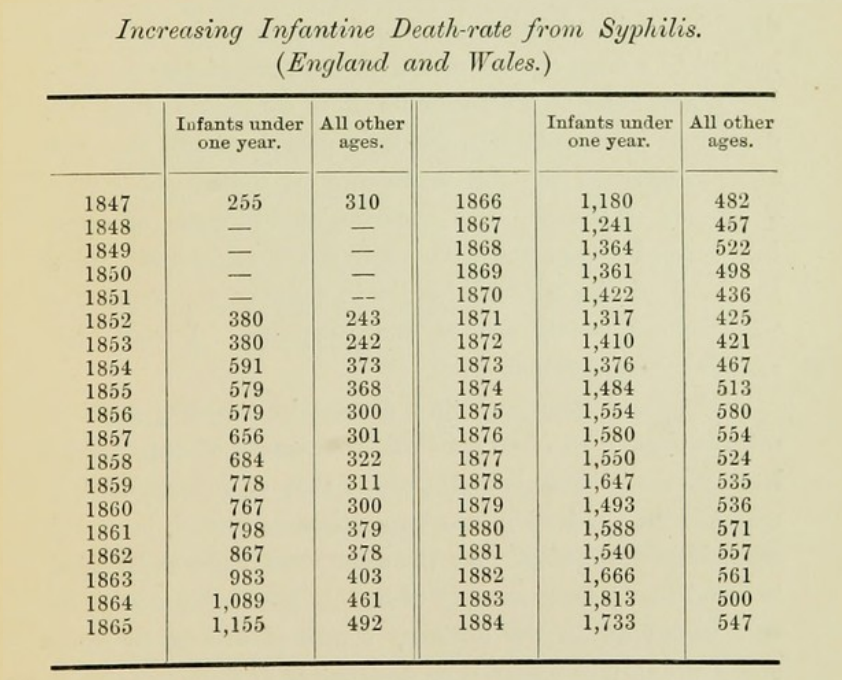What Was ‘Vaccine Lymph’? The Nature of Vaccinia

Introduction
Smallpox vaccination was said to prevent infection with smallpox. However, there is a significant practical difficulty with this argument, aside from statistical evidence and anecdotes of vaccine failure. This is the nature of ‘vaccine lymph’ itself. Although ‘vaccine lymph’ is often considered to be cowpox, the history is a lot more complicated than this, with multiple different lymph sources in circulation. This poses a theoretical problem for those who argue that vaccination prevented smallpox, since they then have to argue that all these sources are equivalent, but this is unlikely.
Horse Grease Cowpox or Spontaneous Cowpox?
Edward Jenner argued that there was more than one form of cowpox in his essay the Inquiry. His Inquiry starts with a description of a disease of the horse, the grease, which he claims is spread to the cow:
In this Dairy Country a great number of Cows are kept, and the office of milking is performed indiscriminately by Men and Maid Servants. One of the former having been appointed to apply dressings to the heels of a Horse affected with the Grease, and not paying due attention to cleanliness, incautiously bears his part in milking the Cows, with some particles of the infectious matter adhering to his fingers. When this is the case, it commonly happens that a disease is communicated to the Cows, and from the Cows to the Dairy-maids, which spreads through the farm until most of the cattle and domestics feel its unpleasant consequences.
Jenner, Inquiry
Jenner is clear in this text that the protection comes via the horse, through the cow, to man.
Jenner distinguishes this from spontaneous cowpox, which he considers not protective from smallpox:
It is necessary to observe, that pustulous sores frequently appear spontaneously on the nipples of Cows, and instances have occurred, though very rarely, of the hands of the servants employed in milking being affected with sores in consequence, and even of their feeling an indisposition from absorption. These pustules are of a much milder nature than those which arise from that contagion which constitutes the true Cow Pox. […] But this disease is not be considered as similar in any respect to that of which I am treating, as it is incapable of producing any specific effects on the human Constitution. However, it is of the greatest consequence to point it out here, lest the want of discrimination should occasion an idea of security from the infection of the Small Pox, which might prove delusive.
So here we have two forms of cowpox. One protects from smallpox, and one does not. Presumably, the lymph used by Jenner in his vaccinations outlined in the Inquiry was horse grease cowpox.

As we can see from this diagram (taken from Crookshank’s History and Pathology of Vaccination, Vol. 1) Jenner’s succession of arm to arm vaccinations had run out, and he had no lymph.
So where did his next set of lymph come from? Enter William Woodville.
William Woodville was the lead doctor of the Smallpox Hospital in London and interested in Jenner’s method. He was able to obtain lymph for vaccination from a cow in Grey’s Inn Lane, London. Woodville had been previously unable to directly inoculate horse grease on the cow’s teat.
Be it observed, however, that this London cowpox was not Jenner’s cowpox. It was not horsegrease cowpox, but the variety stigmatised by Jenner as spurious.
White 1885
However, because Jenner had no source of lymph, the Woodville lymph became the source that was spread across the world, regardless of the fact that it wasn’t horse grease cowpox. So if we take the Jennerian distinction as legitimate, there is a significant argument that the lymph used was not protective. Even if we reject the idea that there is such thing as a horse grease cowpox, there is still the problem of which forms of lesions on a cow’s teat are protective from smallpox, since it is agreed that there is more than one form of disease on the cow’s teat.
Cowpox or Smallpox – Was Woodville’s Lymph Contaminated?
As Woodville worked at the Smallpox Hospital in London, he performed his vaccinations there. This of course meant there was a risk of a patient who may become a vaccinifer contracting smallpox, leading to smallpox being spread along with the vaccine lymph. There were also other issues with how Woodville carried out his tests. Although he ran many more tests than Jenner and was more fastidious in recording his results, in some of his cases he performed the variolous test very early on, while the cowpox pustule was still present:
Ann Pink, a tall girl, of a brown sallow complexion, aged fifteen years. This girl was inoculated with variolous matter, on the fifth day, in the same manner as Collingridge, and both tumours proceeded to maturation, though more slowly than in that case.
Woodville, Cited in Crookshank, Vol 2
He then went on to use some of these cases as vaccinifers (e.g. James Crouch was vaccinated, then inoculated on the 5th day after vaccination, then used as the vaccinifer for case 21). This meant the cowpox matter may well be contaminated with smallpox matter.
As Woodville made differing observations from Jenner, regarding the eruptions on the skin, there were some cases where it seemed evident that Woodville’s patients had smallpox.
Horsepox or Cowpox: Equine Lymph Direct From the Horse
Jenner’s relationship to the horse grease theory of cowpox is not straightforward. Essentially, he advocated it initially, but then failed to mention it in his further essays, likely due to its unpopularity. For example, a notable early vaccine promoter, George Pearson, considered the horse grease part of Jenner’s ideas to be nonsense and openly said so. William White argues that Jenner did this for cynical reasons, i.e. financial gain. Later in his life, however, Jenner essentially returned to the horse and in fact used vaccination (equination?) direct rather than via the cow.
For example, he referred to using equine lymph in his correspondence:
[Mr. Melon] sent me some of his equine virus, which I have been using from arm to arm for these two months past without observing the smallest deviation in the progress and appearance of the pustules from those produced by the vaccine.
Jenner (1813), cited in Crookshank [Crookshank’s emphasis]
It was not just Jenner that use horsepox direct. An Italian vaccinator, Sacco, used horsepox to vaccinate.
Sacco obtained some matter from the ulcerous sores on a horse’s hocks (he gives a startling picture of huge, excavated horse sores in his Trattato of 1809), and therewith inoculated several children at the Foundling Hospital of Milan. He found that the effects were very like those of cowpox virus (as we know, in fact, that they always are) ; and, on trying the children with the variolous test, he found that they were protected just as if they had been cowpoxed.
Creighton, Jenner and Vaccination
De Carro in Vienna also used horse grease in his vaccinations.
This horse material likely ended up in wide circulation due to its usage by these prolific vaccinators.
Humanised Lymph: Did Serial Passage Affect the Disease?
As for most of the 19th century, vaccination was arm to arm, there is a possibility that passing through multiple human constitutions may have affected the disease. Essentially, this passing through multiple humans was a crude form of serial passage. In fact, people considered this in the nineteenth century as well, which is why some in the 1840s wanted to “return to the cow” and create a fresh stock of lymph (see below). They believed that the passage through multiple human constitutions had made the disease too mild to be effective against smallpox. As virologists subscribe to the idea of serial passage affecting the function of viruses, then they have to concede this is probable in the case of artificial cowpox infection. Thus the vaccine given over time is not a consistent virus but had different mutations, meaning that there is a distinct possibility of mutation away from being an effective preventative of smallpox even if Jenner’s original concoction worked (which of course, it did not).
Cowpox or Smallpox II: Smallpox Via the Cow
In the 1840s, the idea became prevalent that the lymph was no longer potent and that a stock should be raised from cows. The idea that smallpox and cowpox were the same disease became explicit (Jenner had said that horse grease was ‘the source’ of smallpox instead, although he did call cowpox variolae vaccinae i.e. cow smallpox). The reason that cowpox protected from smallpox on this view was that it was smallpox, except passed via the constitution of the cow which somehow made it milder. This idea wasn’t really explained, just asserted.
Cowpox was not a widespread disease, making it difficult to find new lymph sources. As such, there were those who attempted to deliberately infect cows with smallpox to generate these new lymph sources.
One of these men was Robert Ceely, who performed extensive experiments involving cows. He gave detailed descriptions of cowpox and also infected cows with smallpox and described the results.
Badcock was another 1840s writer, who wanted to obtain fresh lymph for vaccination:
The only satisfactory mode of obtaining, with certainty, the true vaccine that presented itself to my mind was, therefore, to inoculate a healthy cow with Small Pox matter, as the result of that operation, if any, must be cow Small Pox
Badcock
Badcock used this matter for vaccination and indeed states that he vaccinated ‘several thousand’ with this lymph.
Later in the 19th century, when arm to arm vaccination was abandoned, the method of ‘pure glycerinated calf lymph’ came into vogue and emerged as the main method of vaccination. Again, this involved the deliberate infection of cows with smallpox.
The living calf or heifer is first bound down on a movable tilting table, and its belly is shaved and on the clean, tender skin of a most tender part one or two hundred cuts or scratches are then made, and into these cuts or scratches is rubbed some “seed virus,” obtained directly or indirectly from human smallpox.
Chas Higgins
Goat Pox, Sheep Pox, and Other Follies
Vaccinators also tried different examples of less popular material for vaccination.
One example is sheep pox:
Accordingly, when Sacco, in 1804, obtained variolous lymph from infected sheep at Capua, he gave it to Dr. Legni in the remote Sicilian province of Cattolica to try as a substitute for vaccine in the prevention of smallpox.
Creighton, Jenner and Vaccination
There were also other examples of various lymph being used – goat pox was experimented with in Madrid in 1804. Crookshank also argued that cattle plague was used for vaccine lymph in India.
The Jennerian Vesicle: The Vaccination Standard
What connects all of this? The notion of the Jennerian vesicle. Basically, the standard for ‘successful vaccination’ was whether it produced a correct ‘Jennerian vesicle’ on the arm where the matter was inserted. In other words, so long as the vesicle looked ‘correct’ the vaccination was considered to be successful. It goes without saying that this is not a scientific criteria for judging immunity to a disease. But because all these sources could raise the Jennerian vesicle, they were defended as vaccine lymph and some were widely employed.
Conclusion
The fact that so many different diseases, from so many different sources, were considered and used as vaccine lymph, poses a theoretical issue for vaccinationists. All these sources were adjudged at some point, and by some individuals to be appropriate matter for vaccination and many sources existed in circulation. Yet it is difficult theoretically to argue that all these sources were equivalent and thus, for the vaccinationist, equally effective against smallpox.







